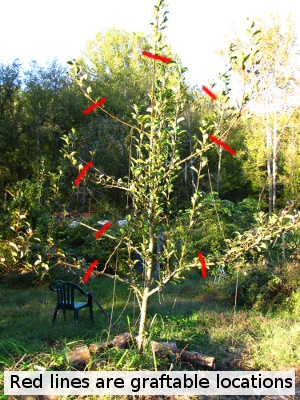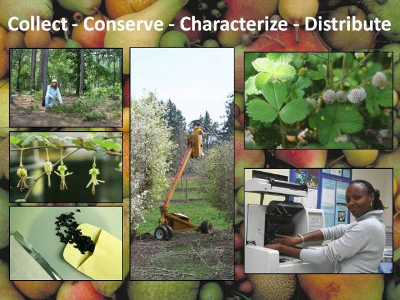
Grafting new varieties onto a pear tree
 Although the flavor of our Kieffer
pear was
disappointing, I didn't want to waste four years of vigorous and
disease free growth. The solution? Graft some new varieties
onto the tree so I get tasty pears.
Although the flavor of our Kieffer
pear was
disappointing, I didn't want to waste four years of vigorous and
disease free growth. The solution? Graft some new varieties
onto the tree so I get tasty pears.
Step
one is choosing varieties. Yup --- I meant to
use that plural. As long as you stay within the same species
(meaning, grafting pears onto pears), you can graft as many varieties
onto a tree as you have branches to graft to. After four years of
growth, I've got plenty of limbs to be converted to tastier fruits.
The factors most
important to me in pear tree variety selection are taste ("dessert
quality" is the word to look for), disease resistance (focusing on fire
blight), and time
of bearing.
Checking with your local extension
service is a good
way to find varieties that work well in your neck of the woods.
Here are the varieties I selected (all of which are fire blight
resistant):
- Dabney - very early bearer, developed in Knoxville (so probably
does well here), and listed as having very good dessert quality
- Tyson - very early bearer, flavor listed as "second only to Seckel"
- Harrow Delight - moderately early bearer, flavor noted to be as good as Bartlett but different
- Seckel --- early midseason, fruits are very small, but many sources list Seckel as having the best flavor of all pears
- Honeysweet --- midseason, flavor similar to Seckel but lacking the bit of grit in the center
- Hoskins --- late bearer and fruits will keep until Christmas, good for dessert
- Luscious --- late bearer, flavor like Bartlett
Step
two is finding scionwood. Scionwood is
basically a twig cut off of another tree that I will graft onto my
existing pear tree. As long as the graft takes, all further
growth on that limb will be the variety of the scionwood, not of the
tree being grafted onto.
 The holy grail of pear tree
scionwood is the National
Clonal Germplasm Repository in Corvallis, Oregon. (There are two other
branches of this government funded program that specialize in other
types of fruit.) It's a bit tough to tell from their website, but
I'm 95% sure that they will send two cuttings of any variety selected
to just about anyone for free --- I've put in my order and will know
more about the process in the winter when the scionwood (hopefully)
arrives. Requests for pear scionwood have to be made by December
1 to be shipped this winter.
The holy grail of pear tree
scionwood is the National
Clonal Germplasm Repository in Corvallis, Oregon. (There are two other
branches of this government funded program that specialize in other
types of fruit.) It's a bit tough to tell from their website, but
I'm 95% sure that they will send two cuttings of any variety selected
to just about anyone for free --- I've put in my order and will know
more about the process in the winter when the scionwood (hopefully)
arrives. Requests for pear scionwood have to be made by December
1 to be shipped this winter.
The Clean
Plant Center of the Northwest (part of Washington State
University) has a slightly less staggering but still pretty good
selection of scionwood available as well. They charge $5 per
"budstick", each of which generally has ten or more buds on it.
For simple grafts, you need two buds apiece, and you can also graft a
bud at a time, so a single budstick goes a long way.
In the commercial
sphere, several nurseries offer small selections of pear scionwood, but
Nick Botner is the best source if you want something even moderately
unusual. Unfortunately, Mr. Botner has no internet presence
(beyond folks mentioning his amazing selection), so you have to mail
your order to 4015 Eagle Valley Road, Yoncalla, OR 97499 or call him at
(503) 849-2781. I've uploaded his 2009 variety list
for your perusal, but you should be aware that internet rumors say he
put his farm on the market this past summer, so Mr. Botner may no
longer be selling scionwood.
Step
three is grafting.
But I have to wait until early spring for that step, so I'll stop here.
Want more in-depth information? Browse through our books.
Or explore more posts by date or by subject.
About us: Anna Hess and Mark Hamilton spent over a decade living self-sufficiently in the mountains of Virginia before moving north to start over from scratch in the foothills of Ohio. They've experimented with permaculture, no-till gardening, trailersteading, home-based microbusinesses and much more, writing about their adventures in both blogs and books.
Want to be notified when new comments are posted on this page? Click on the RSS button after you add a comment to subscribe to the comment feed, or simply check the box beside "email replies to me" while writing your comment.

Great idea to make use of the tree itself to grow different varieties that will taste better. Once you graft on the new wood, will the tree still put out Kieffer branches? About how long will it take for these grafted branches to produce fruit?
And thanks for the info on where to get scionwood. I've never looked into it, but would have never guessed there were these sources for graftable wood.
Keep in mind that a couple of grafting workshops are my only source of information, so take this with a grain of salt... (I plan to do more reading before grafting this winter.) However, my understanding is that I might get fruit from the grafted branches as early as two years from the date of grafting --- since the tree is mature and the scionwood tends to come from a mature tree, it just needs a year to get established before blooming.
You do have to label the scionwood carefully so you know which is the part you want to keep, because the tree will tend to send out shoots of the old variety (known as the interstem). But you have to do that anyway since rootstocks will often send out shoots, and you need to clip those off. So, yes, the tree will put out more Kieffer twigs, but careful pruning will soon make it change its energy to the new scionwood.